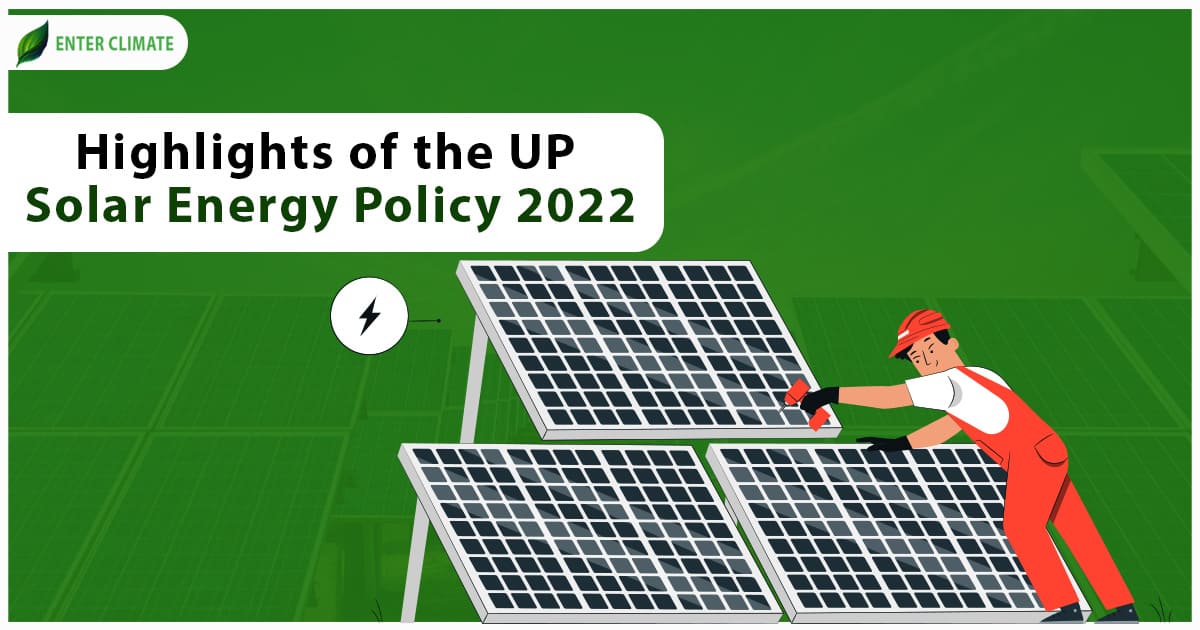Highlights of the UP Solar Energy Policy 2022
 24 May, 2023
24 May, 2023 
Numerous nations have been compelled to look into and switch to environmentally friendly, renewable alternatives to meet the world’s rising energy demand. The focus of the present world as shifted to sustainable energy sources to combat the detrimental effects of conventional fossil fuels on the environment and other issues they cause. Solar energy is one of the finest renewable energy sources with the least damaging effects on the environment. Many countries have developed solar energy programmes to lessen their reliance on fossil fuels and increase their domestic solar energy output. India too has highly invested in Solar energy production. This is evident from the GOI decision to address challenges related to energy development, as well as the growth of the energy sector, including energy production, distribution, consumption and dedicated energy policies. The characteristics of an energy policy may include laws, international agreements, and investment incentives. It is essential for reducing the effects of global warming and the energy shortage. One such policy that the government of Uttar Pradesh introduced in 2022 was The UP Solar Energy Policy 2022, which we will understand in this article.
Overview of Power Generation through Solar Energy
Solar power is the cleanest and the most easily available sources of energy that has negligible contribution to global warming. The sun emits more energy in a second than humans have ever used. Solar energy is widely utilised as an “alternative energy” to fossil fuel energy sources like coal and oil. The availability of cheap, abundant energy with little environmental and ecological risk involved in its production and use is one of the essential factors in accomplishing the desired improvement in the population’s quality of life. As fossil fuels are becoming scarce and costly day by day, the popularity of solar energy is growing. Solar energy has a promising future even if it presently accounts for 3.6% of global electricity generation (through PV), and it remains the 3rd largest renewable energy-related technology behind hydropower and wind. In 2021, power generation from solar PV increased by a record 179 TWh, marking a 22% growth from 2020. Although the initial cost of investment in solar power production is still the priciest form of renewable energy. However, in some remote areas of the globe, it might be the most feasible option currently available for a decentralised energy supply.
Market Overview of Solar Energy in India
India ranks fourth for installed renewable energy capacity[1] (including large hydropower plants), fourth for solar power capacity and fourth in wind power capacity as per the REN21 Renewables 2022 Global Status Report. As a part of a 5-point Sustainability agenda presented at the COP26, India raised its earlier targets and aims to produce 500 GW of non-fossil fuel-based energy by 2030. Between March 2014 and December 2022, the installed renewable energy capacity (including big hydro) increased by around 2.20 times, from 76.37 GW to 167.75 GW. Between March 2014 and December 2022, the country’s total solar power capacity increased by 24.07 times, from 2.63 GW to 63.30 GW.
If we analyse the market, India is the third largest market worldwide and the second largest market in Asia for new solar PV capacity. In 2022, the country experienced the biggest year-over-year growth in the addition of renewable energy, at 9.83%.
India’s total installed renewable energy capacity touched 168.96 GW mark by February 2023-end, Parliament was informed on Tuesday. Out of the total 168.96 GW, 64.38 GW is solar power capacity, 51.79 GW hydro, 42.02 GW wind and 10.77 GW biopower,
If we look at Uttar Pradesh, the total installed capacity is 29,858 MW. Thermal plants, which use coal, petrol and diesel, account for about 72% of the installed capacity. Also, 16% comes from renewable energy, 11% from hydropower, and 1% from nuclear. 2,485 MW (53%) of the 4,727 MW of RE capacity comes from solar power, while 2,193 MW (46%) is generated by biopower. Small hydro contributes the last 1%. The installed solar capacity is relatively low compared to its potential, necessitating significant efforts from all interested parties. The UP solar energy policy 2022, which aims to fast forward the use and acceptance of solar energy, is a start in this regard.
Highlights of the UP Solar Energy Policy 2022
The UP Solar Energy Policy 2022 was implemented by the government of Uttar Pradesh in 2022 to offer affordable and dependable power to the people of Uttar Pradesh. The goal of the policy is to lessen reliance on fossil fuels, achieve an “optimal energy mix” of traditional and renewable energy sources, guarantee energy security, and create an environment that is inviting and promising to private sector investment, particularly in the field of solar energy production and storage. The policy also aims to encourage the involvement of the private sector and invest in solar energy harvesting.
This policy will go into effect on the day it is issued and will be in effect for five years or until the government notifies the new policy, whichever comes first. By 2026–2027, the state is expected to have 16000MW of solar power projects. Through its DISCOMs, Uttar Pradesh Power Corporation Ltd. (UPPCL) would acquire solar energy in accordance with the Renewable Purchase Obligation (RPO) established by UPERC.
Sectors with opportunities for growth under the UP Solar Energy Policy 2022
The major sectors that will benefit after the implementation of UP’s Solar Energy Policy 2022 are:
Construction Sector
- Construction of solar parks.
- Building a Green Energy Corridor in the Bundelkhand region to strengthen the transmission network for solar project evacuation.
Installation of Power Grids/ power lines under UP Solar Energy Policy 2022
- The encouragement of modest, decentralised grid-connected solar power projects through the solarisation of distinct agricultural feeders. To meet the 4.5 GW target stated, the “Saurya Uttar Pradesh Yojna” has been proposed to be executed within the policy period. According to this, the state government will offer subsidies ranging from INR 15,000/kW to INR 30,000 maximum per user. This subsidy will supplement the central financial aid offered by the central government.
- The promotion of solar installation along railway tracks and motorways.
New Projects under UP Solar Energy Policy 2022
- Support for solar energy projects that include storage.
- The promotion of rooftop solar projects using the net metering and gross metering mechanisms, as well as in any other way permitted by the Electricity Act of 2003 and any UPERC Regulations/Orders.
- Promoting solar energy projects atop reservoirs, canals, and other structures.
- Rooftop solar systems, off-grid solar applications, utility-scale grid-connected solar projects, solar power projects with storage, and solar parks are all included in the policy, along with information on the incentives and facilities that apply to each of the installation types.
Major Announcements in the UP Solar Energy Policy 2022
The policy aims to eliminate all obstacles that prevent solar parks and plants from being established in the state. It is predicted that the state will provide a number of alluring incentives (such as exemptions from various tariffs and charges, subsidies, etc.) to encourage investment in the UP solar sector.
- To establish a 24-hour electricity delivery, the UP Solar Energy Policy 2022 also suggests a capital state subsidy of INR 2.5 Crore/MW for utility-scale solar power projects. Currently, the state DISCOMs get a large portion of their electricity from coal sources (about 75%), and just 3–4% of their electricity comes from solar sources. In addition to closing coal facilities, DISCOMs must raise the supply share from such solar plants for this effort to be implemented successfully.
- Due to the power purchase agreements that are related to the coal plants, DISCOMs will still be required to pay a set cost to the coal plants. For this reason, a techno-economic analysis combining solar developers, DISCOMs, and coal plant generators is required to support this programme and assist in supplying consumers with clean energy.
- In addition, the policy mentions the creation of a high-level committee to handle major snags in its execution and any potential inter-departmental disputes. In this instance, coordinated decision-making amongst multiple stakeholders, including customers (residential, agricultural, etc.), DISCOMs, solar plant developers, and regulatory commissioners, would be necessary to implement the UP Solar Energy Policy 2022.
- Furthermore, the state government made a wise choice by including a capital subsidy provision for installing battery storage systems, which is a first among all the states. Even yet, the state exchequer is anticipated to bear a financial burden of INR 7,700 crore due to the execution of all policy provisions.
Conclusion
It can be unarguably said that one of the most promising renewable sources today for India is solar energy. Starting a business in any of the above sectors identified above will be a promising business investment in the State of Uttar Pradesh after the implementation of UP Solar Energy Policy 2022. Solar thermal and solar photovoltaic (PV) methods will soon be used to harness solar energy for private use/industrial consumption in the state, and entrepreneurs can capture a good share of this opportunity by generating energy for private/ industrial use and can sell the surplus power to DISCOMS at attractive prices that are being guaranteed by the government today. Solar energy is the way forward, and starting a business in and around solar energy generation, storage, installation etc. will undoubtedly be profitable, considering the rising global energy consumption in the state. However, to tackle all the business setup legalities, one must take the assistance of licensing and environmental experts to make the process economical, swift and hassle-free.
Read our Article: Environmental Justice Issues In India
Categories
Latest Post
Air pollution Dispersion Modeling
Natural Disaster Risk Assessment
Endangered Species Protection
Aquifer Recharge Project
Sustainable Sanitation Solutions













